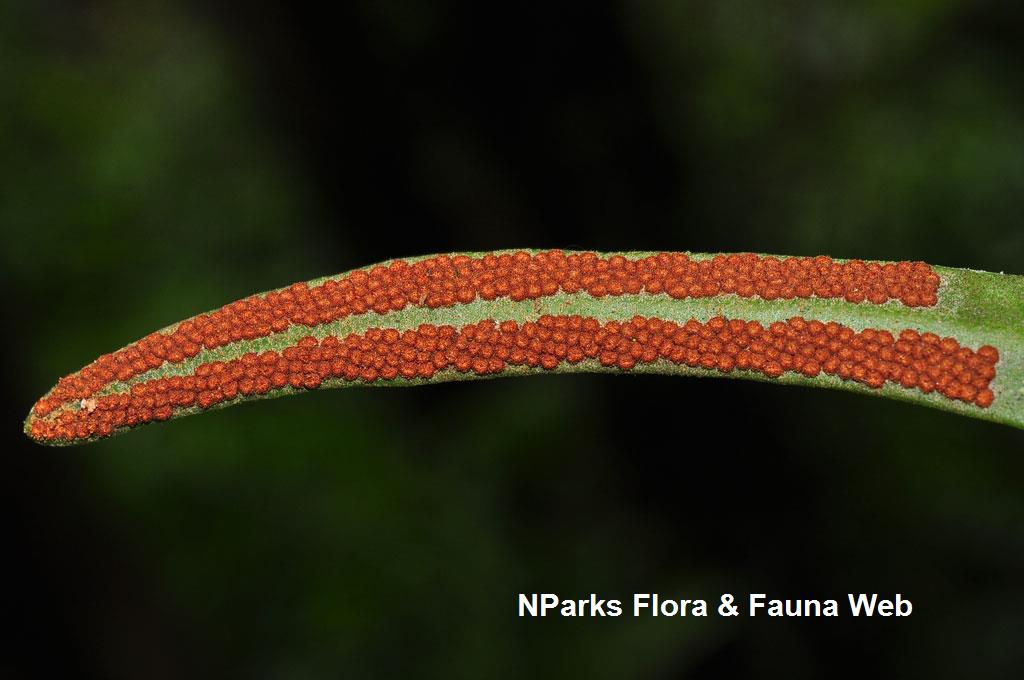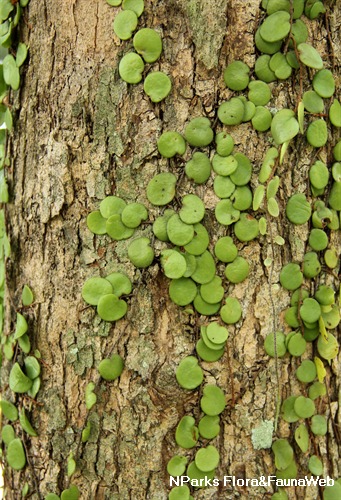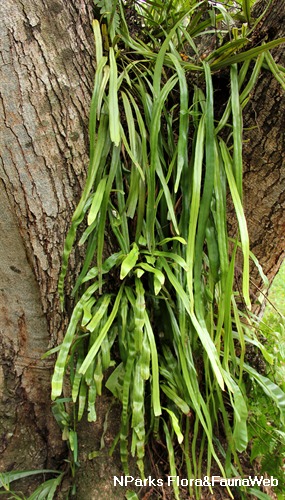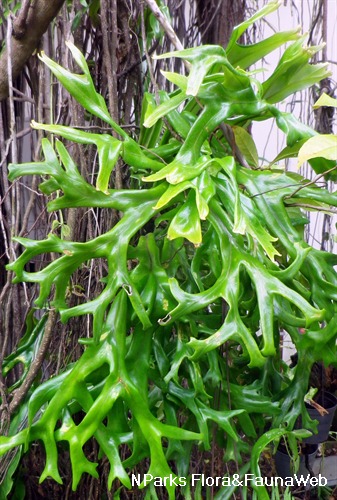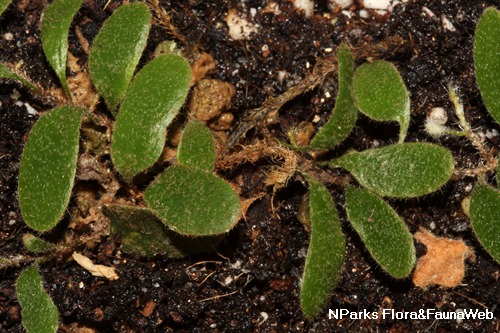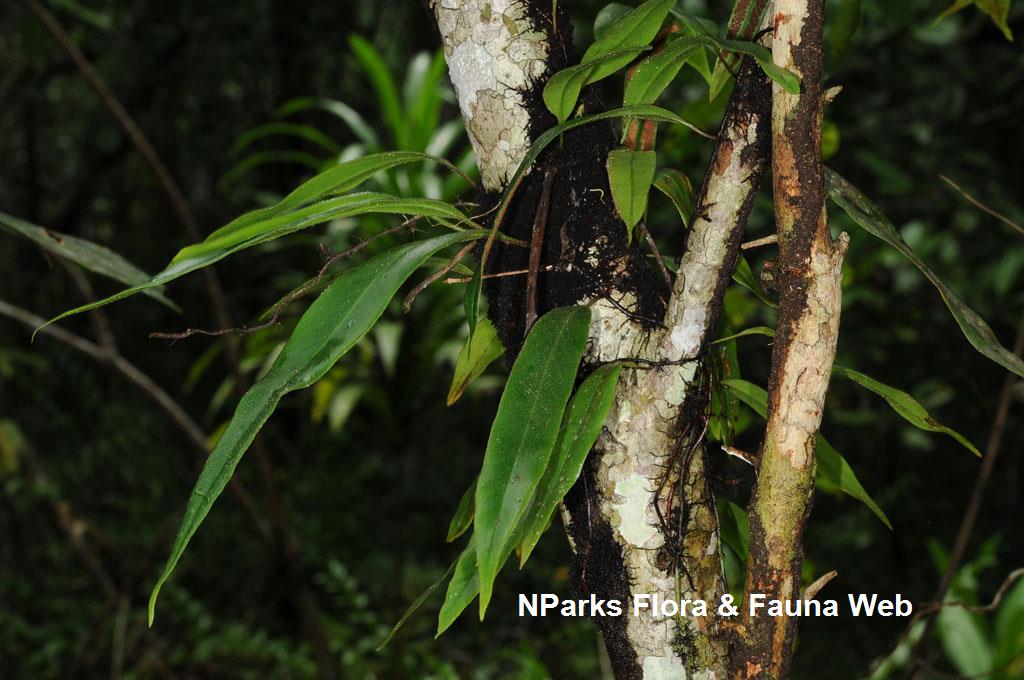
Back
Pyrrosia lanceolata (L.) Farw.
| Family Name: | Polypodiaceae |
| Synonyms: | Acrostichum lanceolatum L., Pyrrosia adnascens (Sw.) |
| Common Name: | Lanceleaf Tongue Fern |
Pyrrosia lanceolata or Lanceleaf Tongue Fern is an epiphytic fern native to Singapore. It has linear-lance shaped fronds, slender rhizomes and round sori found at the tips of the fronds extending to the entire blade. Scales on the rhizomes are dark brown, egg-shaped with hairy, pale margins.
Name
Classifications and Characteristics
| Plant Division | Ferns & Lycophytes (Non-Seed Vascular Plants) (Fern) |
|---|---|
| Plant Growth Form | Herbaceous Plant |
Biogeography
| Native Distribution | Africa, Southeast Asia to to Pacific Islands |
|---|---|
| Native Habitat | Terrestrial (Primary Rainforest, Secondary Rainforest) |
| Preferred Climate Zone | Tropical |
| Local Conservation Status | Native to Singapore (Least Concern (LC)) |
Description and Ethnobotany
| Growth Form | It is a epiphytic fern with long creeping and slender rhizomes, it can also be found growing as a terrestrial plant or on the surfaces of rocks. |
|---|---|
| Foliage | The fronds are produced 2 - 5 cm apart, dimorphic, thick, leathery, linear-lanceolate, tapering on both ends measuring 5 - 13 cm long and up to 5 - 13 mm wide covered in star-like hairs on both sides. The fertile fronds with stalks grow to 9 cm long, measuring 3.5 - 31 cm long, 0.3 - 3.5 cm wide while the sterile fronds tend to have a shorter stalk to 0.5 cm long, measuring 2 - 24 cm long by 0.3 - 4.3 cm wide. |
| Reproductive Parts - non-flowering plant | The sori are round, found at the tips of the fronds extending to the entire blade on the underside. |
| Others - Plant Morphology | The rhizomes are long-creeping, flexible about 1.5 mm wide, densely covered in scales. Scales are dark brown, ovate (somewhat triangular) with pale and very hairy margins. |
| Habitat | Occurs common in a wide variety of habitats. Mostly at low altitudes, sometimes up to 1000-1500 m. Often found on trees in coastal areas and on street trees. <1,2> |
| Similar | Pyrrosia lanceolata is similar to Pyrrosia longifolia. The key difference is Pyrrosia lanceolata have flexible rhizomes, scales with hairs on the margins and dimorphic fronds. While the latter have rigid rhizomes, smooth margin and monomorphic fronds. Pyrrosia lanceolata have egg-shaped scales with hairy pale margins while the latter have circular scales with pale margins that are not hairy. |
| Cultivation | It can be propagated by spores. |
Plant Care and Propagation
| Light Preference | Semi-Shade |
|---|---|
| Water Preference | Little Water, Moderate Water |
| Plant Growth Rate | Moderate to Slow |
| Propagation Method | Spore |
Foliar
| Foliar Type | Simple / Unifoliate |
|---|---|
| Foliar Shape(s) | Non-Palm Foliage (Lanceolate, Linear) |
| Foliar Margin | Entire |
| Foliar Apex - Tip | Acute |
| Foliar Base | Attenuate |
References
| References | <1> Hovenkamp, P.H. (1998). Pyrrosia. In: Hovenkamp, P.H. (ed.) Polypodiaceae, Flora Malesiana ser. 1, Pteridophyta, vol. 3, pp. 161 - 162. Leiden: Rijksherbarium. <2> Tagawa, M. & Iwatsuki, K. (1985). Flora of Thailand, vol. 3(4), pp. 486 - 500. Bangkok: The Forest Herbarium, Department of National Parks, Wildlife and Plant Conservation. |
|---|
Image Repository
Others
| Master ID | 34015 |
|---|---|
| Species ID | 8431 |
| Flora Disclaimer | The information in this website has been compiled from reliable sources, such as reference works on medicinal plants. It is not a substitute for medical advice or treatment and NParks does not purport to provide any medical advice. Readers should always consult his/her physician before using or consuming a plant for medicinal purposes. |

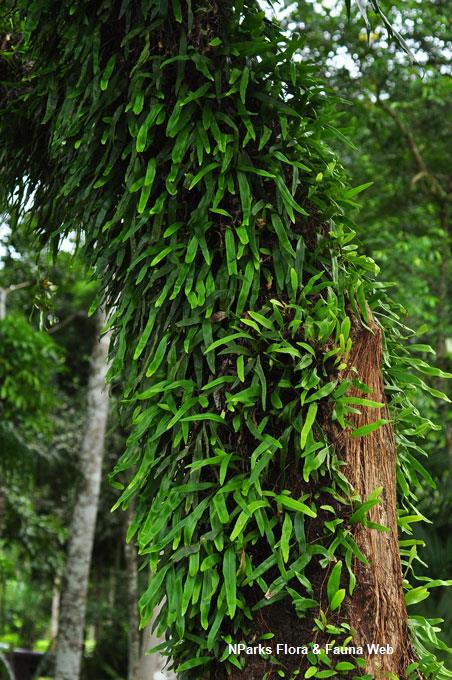
.jpg)
.jpg)
.jpg)
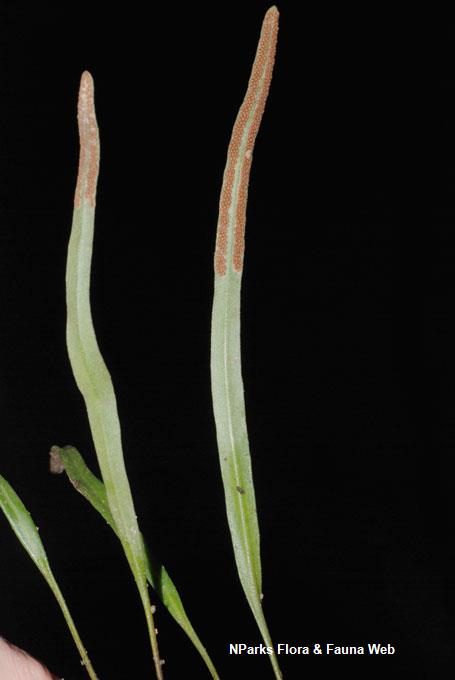
.jpg)
